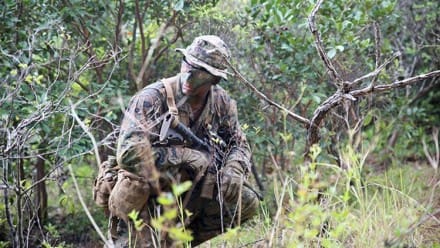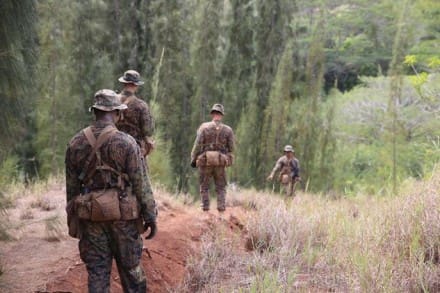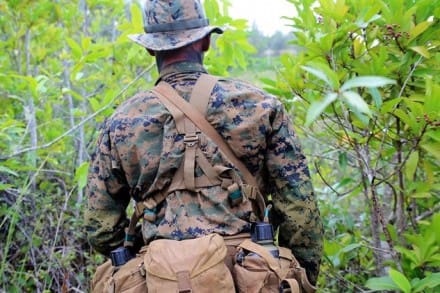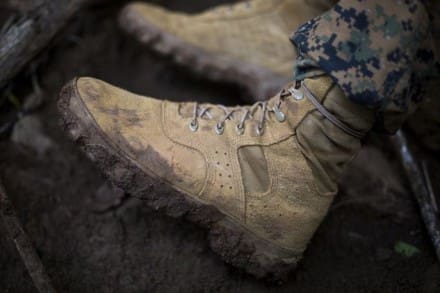MARINE CORPS BASE QUANTICO, Va. —
The Marine Corps wrapped up its fourth and final field user evaluation for a prototype tropical utility uniform and boots in late September.
Between June and September, 400 Marines from 3rd Battalion, 3rd Marine Regiment put the new uniform and three types of boots to the test in a tropical climate. The testing was done in various locations on the island of Oahu, Hawaii.
“About four years ago, then Commandant Gen. James Amos directed us to explore tropical uniforms and boots for Marines,” said Todd Towles, program analyst for the Clothing and Equipment Team at Marine Corps Systems Command. “When he became commandant, Gen. [Robert] Neller followed up on the initiative, which brings us to where we are today.”
To date, MCSC has tested five different fabric types and four boots, downselecting to the single uniform fabric and three boot options that 3rd Battalion, 3rd Marines tested. The goal of the final FUE was to collect feedback about the durability, fit and function of the prototypes that will be included along with other data in a decision package during the second quarter of fiscal year 2018.
“When our program office goes out [to conduct a FUE], we talk to the Marines about what we’re testing and why,” Towles said. “We ask them to wear the uniform every day, whether they’re in the field or a classroom. At the end of the FUE, we conduct surveys and focus groups where we inspect the uniforms and talk to the Marines about wear and tear, how the uniform feels on the body and whether or not they could conduct their mission. If it interferes with the mission or training, we want that feedback as well.”
The tropical uniform prototype is made from a lighter-weight material than the current Marine Corps Combat Utility Uniform. The fabric is also designed to dry faster and keep Marines cooler in warm climates than the current utilities.
“The tropical uniform is made with the same fiber blend—nylon and cotton—as the MCCUU, but the fabric construction and weight are different,” Towles said. “The tropical uniform is approximately 30 percent lighter than the MCCUU.”
The uniform also has a slightly heavier, reinforced fabric in the elbow, knee and groin areas to provide higher abrasion resistance against the mountainous terrain and dense vegetation of tropical environments.
“I prefer to wear these over the [current uniform] because they have thinner, lighter material,” said Lance Cpl. Kyle Herzog, an infantryman with 3rd Battalion, 3rd Marines. “It’s hot and humid here, and the current ones are thick and not as breathable. Once it’s wet, it’s damp or wet for days at a time. The [new uniform] dries within an hour. For Marines stationed in this environment, new cammies are a must.”
The boots—designed by three different manufacturers—are intended to have a self-cleaning outsole and dry faster than the current boot. They are also a half pound to one pound lighter than the current boot out of the box, and thus much lighter when wet, Towles said.
“We had several different types [of boots], and all of them dry much faster than the regular boot, and they’re really light, so that’s been a huge combat multiplier for us,” said Battalion Operations Officer Maj. Evan Ota.
Marines could know as early as 2018 whether a new tropical uniform and boots will make their way to the fleet. If so, Marines slated to deploy or already stationed in tropical climates will be the first to have access to the items. The tropical uniforms and boots will be owned by the Marine Expeditionary Force supply and issued for contingency operations. Uniforms and boots could be available for optional purchase by Marines, pending certification.
“What we see throughout the Pacific is it’s a very hot, humid and wet environment with a lot of jungle and mountainous terrain,” Ota said. “So, anything you can do to lighten the load, dry yourself out quicker, take care of your feet and take care of your body definitely adds to your combat effectiveness.”
Article and Photos By Monique Randolph, MCSC Office of Public Affairs and Communication | Marine Corps Systems Command






What belt kit are they wearing?
My question too. Would love to see a post on what Marines are wearing for war gear these days. Seems to change so fast.
As for the uniform: Here we go again. The Corps has made attempts in the past at lighter weight tropic utilities, but they could never stand up to everyday use and abuse. Maybe this time they got it right?
Looks like it could be their molle belt system. I’m not sure of the suspenders with on the close up of the one Marine.
I can tell that they are using issue canteen covers, and what looks like an issue large utility pouch as a butt pack.
It’s interesting on the what old is new again.
Really goes to show about what gear works the best for what situation.
I just smile and nod when people start talking about old LBEs and their antiquity.
I’m just glad that it looks like some lessons learned are not lost to time.
The suspenders are issued with the sub-belt.
I came to the comments with this exact same question
Looks like USMC issue sub-belt sans suspenders (strap are for the issue chest rig) with assorted pouches: canteen, IFAK and PVS-14/GP
Remind me again why the Army and Marines have their own jungle uniform? Are they fighting in different jungles? No? Hmmm.
This is low quality bait.
+1,000
While the coyote gear and slings match the dirt road, they seem to stand out against the vegetation. Maybe olive drab or ranger green is a better color for universal gear?
Don’t forget they want everything to be Coyote tan, including guns…because nothing matches the jungle more than desert colored guns.
Guess that depends on whether you are strict about your definition of jungle. Lots of hot humid tropical- subtropical areas with underbrush that thins out under the trees,. In this case though from the comments above this web gear is pieced together from existing gear, not specifically made for jungle use.
Bumpacks!
I knew they would come back!
Now for flairs, disco & 8 track!